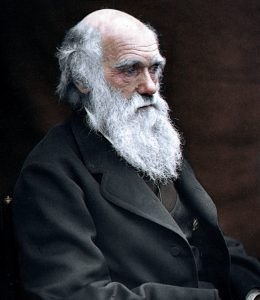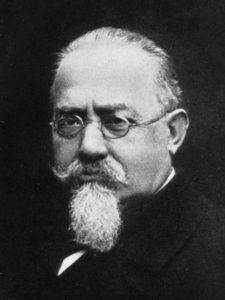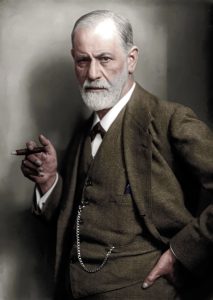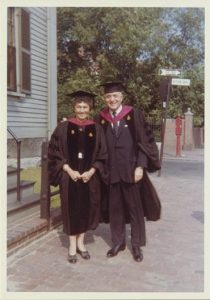2.6 The Positivist School of Criminological Theory
Brandon Hamann
The Positivist School of Criminological Theory was in direct conflict with the Classical School. Think of it like two people who think they know everything having a very loud argument in public. While the Classicists believed that criminal behavior could be explained through rationality of choice and a cost/benefit analysis (more on this later), Positivists believed criminal behavior was a product of scientifically explained phenomena. It was not a matter of choice, according to Positivists, but a matter of observable, empirical fact that criminality could be identified. And there was no better way to prove it than with…SCIENCE!!! The Positivists can be broken down into three subsections: the Biological Positivists, the Psychological Positivists, and the Social Positivists, or as they are more commonly known, the Chicago School.
The Biological Positivists
The Biological Positivists were not Criminologists in the general definition of the word. Not really. They looked at the Social Sciences as some kind of mutated disease because all they did was theorize all day. None of their theories were verifiable because there was no concrete proof to say whether what they were talking about was true or not. At the time, the only true science was medical, or biological science; all other science was pseudoscience – statements or beliefs not based on scientific facts – or “fake science.” So, the medical/biological scientists went out to prove that they knew better how to answer the questions about criminal causation that the so called “Social Scientists” were just theorizing about. The Biological Positivists believed that some people were born criminals, and some were not, and medical/biological science was going to be the tool that could prove it.

The first scientist to give the Biological Positivists their argument for how criminal behavior was caused was none other than Charles Darwin (1809-1882). Charles Darwin, a British naturalist who is considered the founder of evolutionary science, wrote On the Origin of Species (1859), where he observed what he later conceptualized as natural selection – survival of the fittest. A few years later, he applied his observations to humans in Descent of Man (1871), where he exclaimed that some humans may be an evolutionary throwback to a primitive version of modern mankind (Fedorek, 2019). Darwin never wrote about human criminal behavior causation specifically, but his works on species evolution did have a major influence on the Biological Positivists to come (Fedorek, 2019).

Perhaps the most influential Biological Positivist was Cesare Lombroso (1835-1909), an Italian phrenologist, physician, and the founder of the Italian School of Criminology. What made Lombroso so influential was his use of the Scientific Method in his research experimentation, which helped to legitimize Criminology in the minds of the medical experts as a valid field of scientific study. However, the means by which he went about his experiments left much to be desired. Lombroso published The Criminal Man (1876) five years after Darwin drafted his book on evolution and claimed that a third of criminals were born that way because they were atavistic – evolutionary throwbacks (Fedorek, 2019). He even went out to prove his theory by developing experiments which measured criminality by physical trait variables: the slope of the forehead, the position of the eyes, the size of the ears, the drop of the mouth, even the color of skin. Widely condemned by experts, Lombroso would later reject his own theoretical rhetoric as he got older, realizing the discriminatory practices of his work, but the groundwork he laid in legitimizing the field of study was immeasurable, because now any Criminological research follows the same procedural process that was developed by Lombroso’s experimentations.
The Psychological Positivists

Best known for his work in the psychological field of personality disorders, Austrian neurologist and psychoanalyst Sigmund Freud (1856-1939) postulated that the human mind was separated into three distinct psychoanalytical types: the Id, the Ego, and the Superego. Through his studies, Freud theorized that criminal behavior was a product of mental illness, motivated by unconscious psychosexual conflict (Fitzpatrick, 1976). The Id, according to Freud, was the part of the human mind that controlled basic animalistic urges (fear, anger, compulsion, etc.) and was the most basic and earliest to develop, usually in childhood. The Ego helped to control the Id and began to mature as the child matured and learned from its surroundings and its parents what was good behavior and what was bad behavior. The Superego kept everything from going bonkers, hopefully.

Then there were those who wanted to study the personality traits of criminals. Sheldon and Eleanor Glueck (1950), Polish-American criminologists, determined that there was no such thing as a criminal personality, but that there were some personality traits that were clustered together (Fedorek, 2019). Their work included a longitudinal study – a type of experiment that takes a long time to complete, usually decades – of 1000 teenage juvenile delinquent and non-delinquent boys to try and understand the causes of criminal behavior in youths. Their findings resulted in no explanations as to the causation of delinquent behavior. However, there were correlations in certain personality types and criminal behavior: low self-control, low empathy, and an inability to learn from punishment (Fedorek, 2019).
criminal behavior is a product of scientifically proven phenomenon.
statements or beliefs that are not based on scientific fact.
evolutionary throwbacks.
3 distinct psychoanalytical types of the human mind.
experiment that takes a long time to complete, usually decades.

